the science of photosynthesis
Photosynthesis : top level summary
There are nine environmental inputs that aid plant growth
Light drives photosynthesis and impacts the other 8 parameters
If light intensity increases, all other inputs need to be balanced to achieve optimal growth
Balance is key
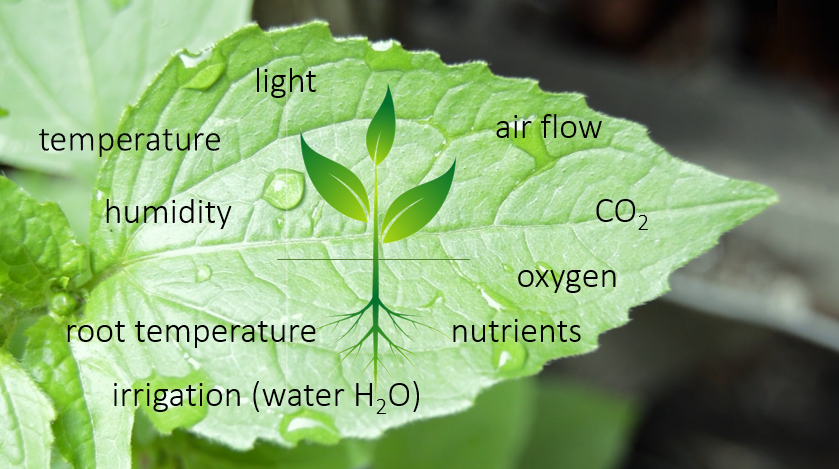
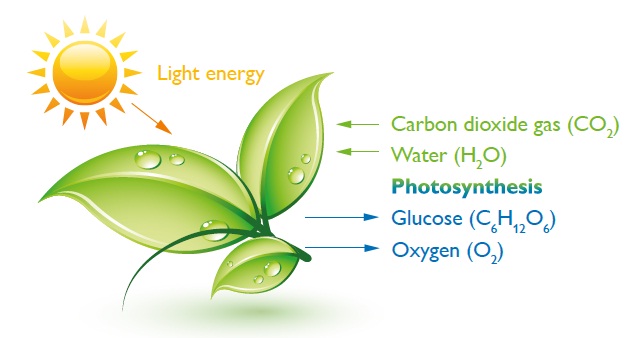
Photosynthesis is a truly amazing chemical process carried out by plants
During photosynthesis, plants use light energy to trigger a series of chemical reactions that convert water (H2O) and carbon dioxide (CO2) into sugars (carbohydrates) which are carried around the plant by ATP molecules
The by-product of the photosynthetic process is Oxygen (O2)
To achieve optimal plant growth and high yield harvest it is important to provide sufficient oxygenated water, nutrients and CO2 that is in balance with the light intensity applied
deeper dive
Photosynthesis takes place in the leaves
Leaves contain plant cells containing chloroplasts, these are small structures that contain chlorophyll
Pigments are molecules that create the colour of plants and are made up of chlorophylls, Carotenoids and Phycobilins.
Chlorophyll are green-coloured pigments that absorb blue and red light
There are three types of chlorophyll a which is the most abundant pigment in plants, chlorophyll b which is not as abundant but increases the range of light a plant can absorb, and chlorophyll c which is found in certain marine algae
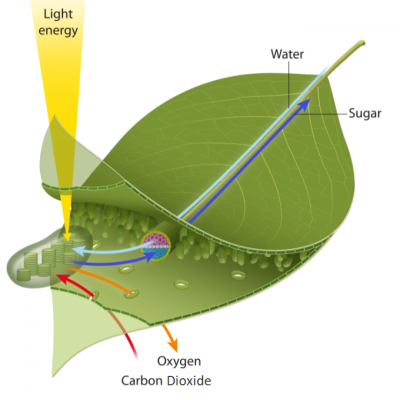
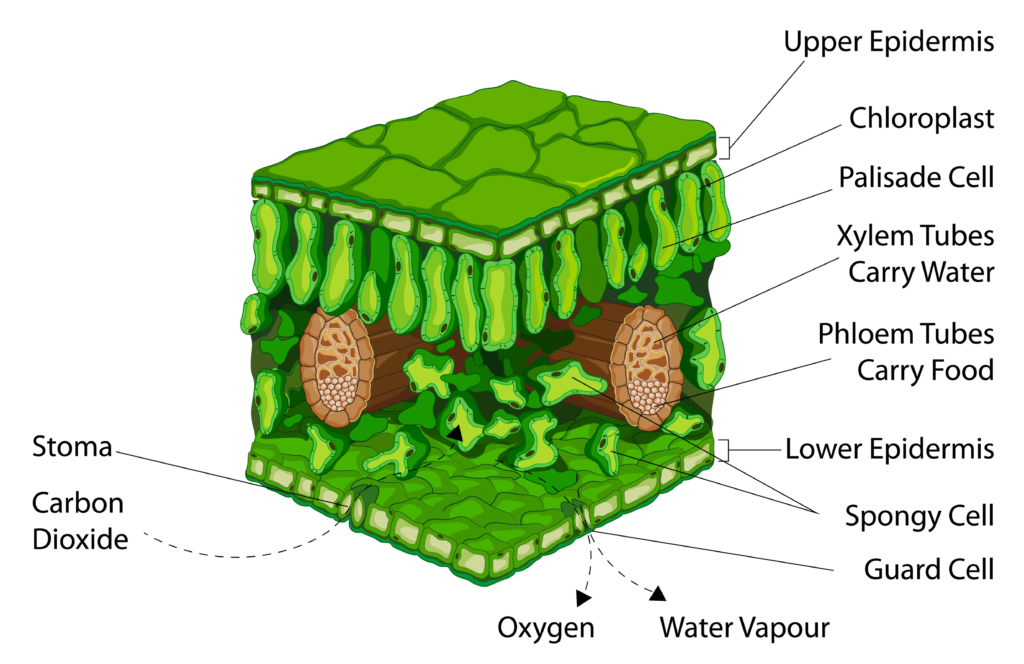
Chlorophyll a absorbs light maximally at 430nm and 662nm, chlorophyll b maximally at 453nm and 642nm and chlorophyll c maximally at 447 to 452nm
Caretonoids are red, orange and yellow-coloured pigments and absorb bluish-green light between 460nm and 550nm
Phycobilins are red or blue pigments and absorb wavelengths of light that are not well absorbed by chlorophylls or caretonoids and are generally only found in bacteria and red algae
When a photon of light hits the chloroplasts, the pigment molecule chlorophyll releases an electron
The electron travels through an electron transport chain and produces ATP (adenosine triphosphate, a source of chemical energy for cells)
ATP drives chemical reactions that fix carbon and hydrogen atoms from CO2 and H2O to create a single carbohydrate molecule (glucose)
The electron hole in the chlorophyll is filled by taking an electron from water which results in the release of oxygen
During photosynthesis, plants draw in carbon dioxide, water and light
When a plant detects light, the stoma on the underside of the leaves open
Stoma are small “pores” on the underside of a leaf and open to allow CO2 to be drawn into the plant
The root system absorbs water and oxygen through root hair cells
Light provides the energy needed to allow photosynthesis to take place
In this process carbon dioxide and water are converted into oxygen and sugars (carbohydrates)
Oxygen is released through the stoma as a by-product of the photosynthetic process
Sugars are transported around the plant in the phloem vessels
Leaves have a large surface area to maximise the amount of sunlight they can absorb
They are thin, allowing easy diffusion of gases into and out of the leaf and transmission of some light wavelengths through the leaf
They have veins (called xylem and phloem) to allow the water, mineral ions and sugars (food) to be transported to the plant stem and then onto the rest of the plant
Plants need to absorb oxygen
Oxygen is absorbed through the root structure in the form of water H2O and gaseous oxygen
aerated or oxygenated water is a key requirement for hydroponic systems
The equation for photosynthesis is:

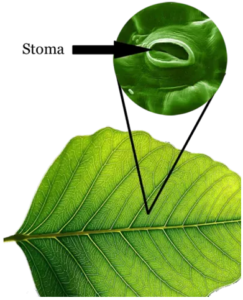
co2 enhancement
The opening and closing of stoma is triggered by a number of environmental factors: Light, cardon dioxide levels, humidity, temperature
Stoma typically open with the application of light on the plant. They typically close at night when the plant is not Photosynthesising
If temperature is too high or humidity falls too low in the grow room then the stoma will close and the photosynthetic cycle will be compromised to prevent or limit moisture loss (evaporation).
If CO2 levels are too low, the stoma will close to reduce O2 losses and the photosynthetic process will be compromised.
Keeping the plant in balance is key
As oxygen is produced and released by the plant it is important to ensure CO2 levels are similar to or higher than normal atmospheric levels
Typically normal atmosphere contains 400 ppm of CO2
By circulating outside air into your grow room and venting internal air, natural CO2 levels will be retained.
Elevating CO2 levels to 1200 to 1600 ppm will significantly enhance the chemical process driven by photosynthesis and increase plant growth
Higher light levels are required to make full use of enhanced CO2
F.A.Q.
if you cannot find the answer to your question then please send via contact page
Light generates photosynthesis in plants but during the night, plants continue to metabolise, process the sugars and energies generated from photosynthesis and respire. Some plants are photosensitive and will only bloom (flower) when night-time periods reach a certain length. Other plants can grow happily in 24-hour light.
Different types of plants require different levels of light. The total amount of light energy absorbed by a plant is known as the daily light integral (DLI). Some plants such as salad crops require low levels of DLI whilst others require very high levels. See the lighting section in our tech centre for more info.
Seeds generally speaking require no or very little light in order to successfully germinate. Adding light may stop your seeds from sprouting. Once a seed has sprouted it becomes a young plant or seedling.
Yes. Once a seed has sprouted its first roots and first small leaves, it becomes a seedling and will require light, and quite a bit of light, for 16 to 18 hours a day in order to grow into a mature plant. Transplant your seedling into a propagator with a lid, keep them warm and moist and apply light. See our tech centre hydroponics section for more information.
Short-day plants are sensitive to the balance of Pr and Pfr in phytochromes triggered by the night or day period. Far red light, present in the shade or at night, converts Pfr to Pr and red light, present in the day, converts pr to Pfr. Applying a small dose of far red light for an hour a night in the last few weeks of the vegetative phase during late summer glasshouse growing induces faster flowering of short-day plants. .
Certain crops require a lot of light for photosynthesis. Blue light induces shorter stems, more compact plants whereas red light induces stem elongation, faster leaf development and flowering. If you use a broad spectrum LED light with a high level of light efficiency that generates high PPFD then the spectrum contains sufficient blue and red light to grow string, healthy plants. In certain crops, the Veg and Bloom phase is triggered by the photoperiod (number of hours of light used) rather than the spectrum.
